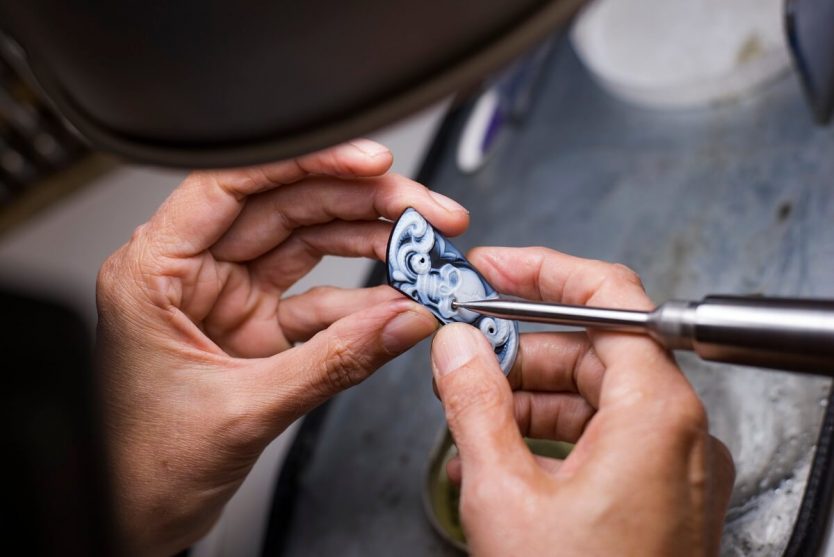At STEPHAN, we love our craft because craftsmanship isn’t just a word for us. The renaissance of the cameos has revitalised the traditional craftsmanship of the gem engraving industry. We wish to introduce two of our engraving artists: Susanne Mueller-Ostgen and Anja Schuessler.
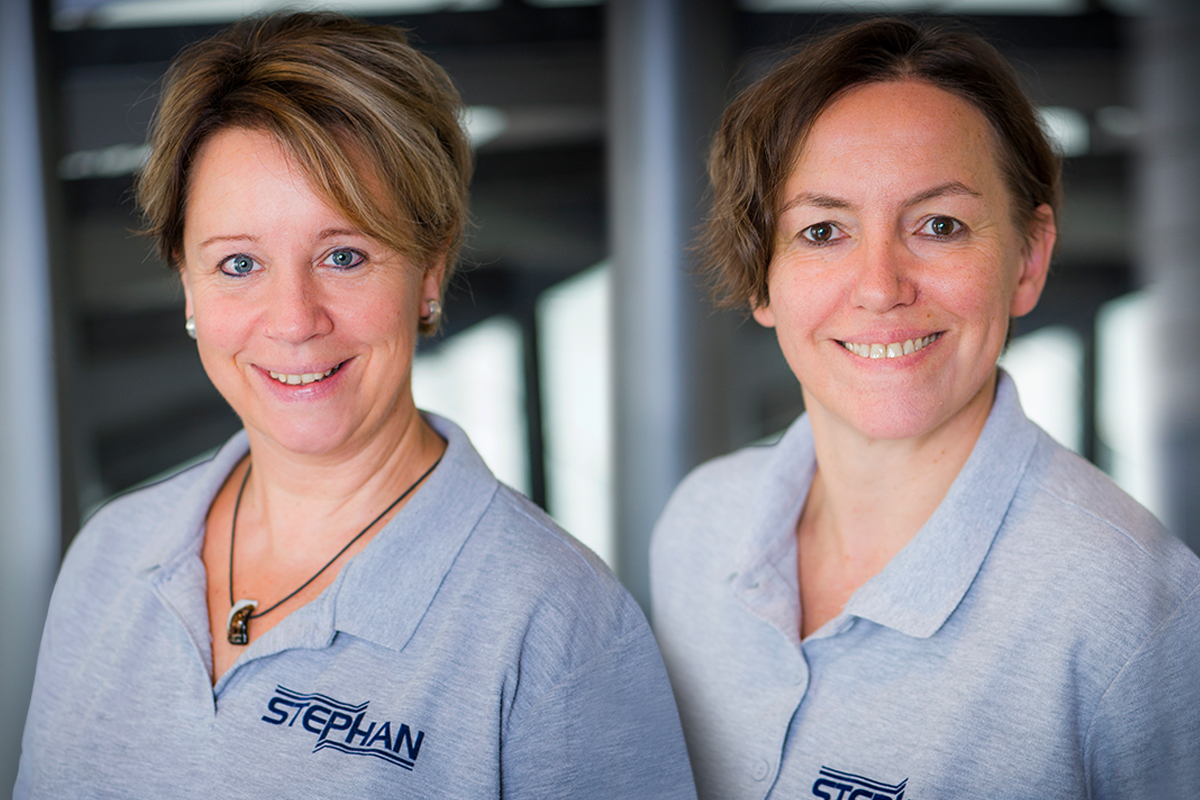
Susanne Mueller-Ostgen (left) and Anja Schuessler (right)
What made you become an engraving artist?
Susanne Mueller-Ostgen:
As a child I already knew that I wanted to have a creative career. My favorite subjects in school were accordingly: art, crafts and needleworks. In my spare time, I always enjoyed arts and crafts, constructing and drawing.
Anja Schuessler:
In my childhood days, I spent lots of time creating things, especially drawing and painting. Growing up in the town of Idar-Oberstein was fortunate for learning the art of gemstone engraving which combines both my interests.
Have you ever considered learning a different profession?
Anja Schuessler:
I remember at one time being interested in becoming a ceramic artist. But, the fact that I had to move to another town in order to get trained, made me put it off. Though I have never regretted staying in Idar-Oberstein.
Susanne Mueller-Ostgen:
I have never wanted anything but a creative career. Having to do an office job would probably have killed my creative instinct. (laughs)
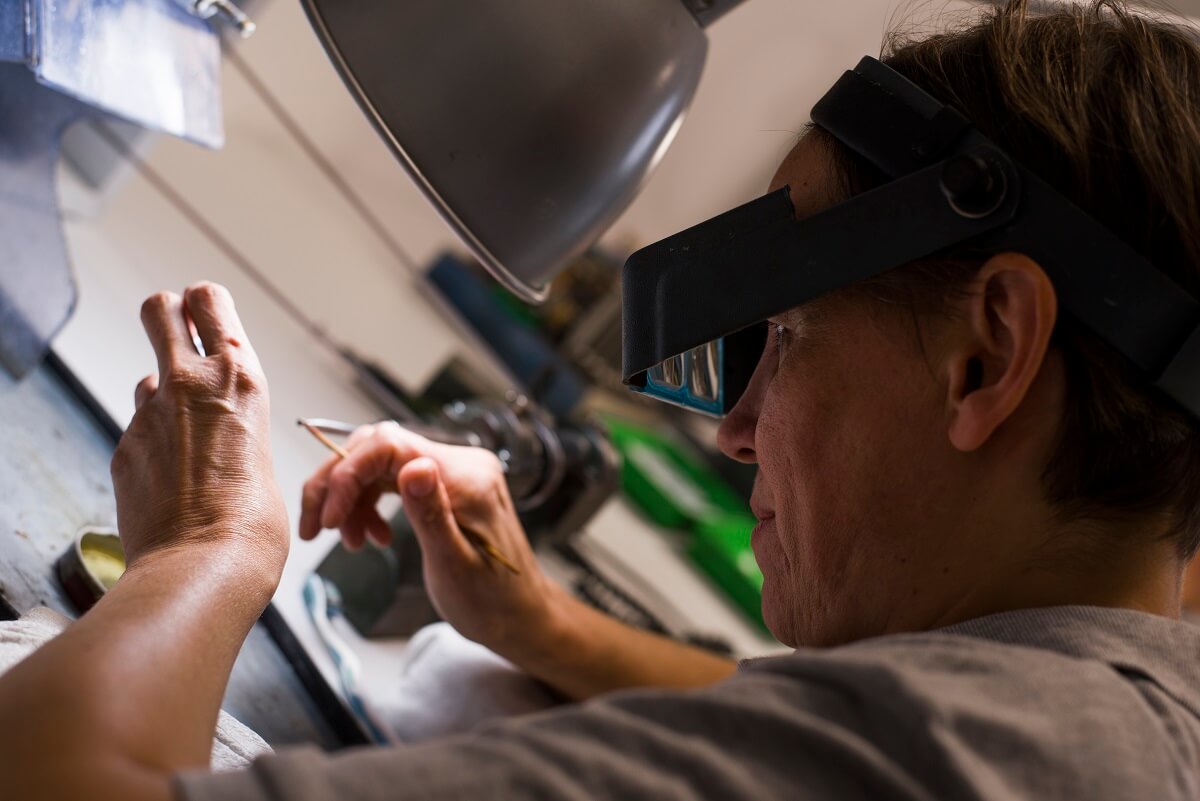
Anja Schuessler applying oil (coolant) to the tools
Which are the most important skills an engraving artist must possess?
Anja Schuessler:
As far as I am concerned, it takes drawing skills, spatial ability, keen eyes, discipline and patience, a sense of aesthetics and creativity.
Susanne Mueller-Ostgen:
A steady hand is of course very important. I would also add a profound knowledge of the human anatomy to the necessities.
What were the highlights of your apprenticeship and then career?
Susanne Mueller-Ostgen:
During my training, the highlights consisted of putting into practice what I had been taught and experiencing the contentment of my master. His consistent strictness made me the engraver I am today.
Anja Schuessler:
My years of training were very intense and therefore could not be considered full of highlights. When you become an engraver, there is a lot of criticism you have to take before being able to work on a gemstone all by yourself or even earn credit for your work. The necessary self-confidence for this craft is not achieved before years of experience and that’s when the highlights set in. My best moments include the times in New York where I was able to present my creations and engravings to a local customer.
Susanne Mueller-Ostgen:
I have great memories with the STEPHAN company sending me to Japan to demonstrate the art of engraving to some interested locals. Recently, however, I found great pleasure in creating extravagant, individual pieces.
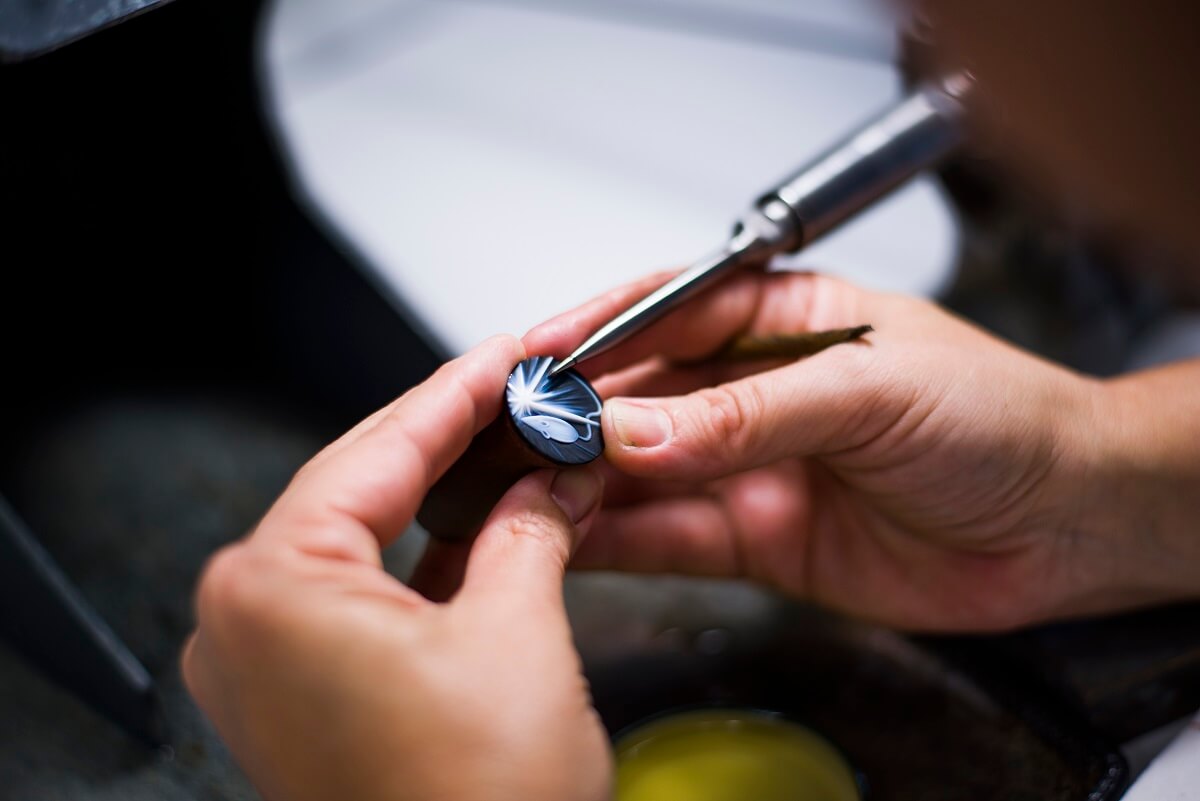
Susanne Mueller-Ostgen at the spindle, close-up of the engraving
The engraving of gemstones is an old traditional craft. How can it survive in modern time?
Anja Schuessler:
You cannot be sure if or how a traditional craft will make it through today’s fast pace. Though with STEPHAN always being on the pulse of current events and open to new trends, this craft may remain successful and interesting.
Susanne Mueller-Ostgen:
You always have to keep an open mind to all opportunities.
What do you consider most important for your craft? The steady hand or a sharp vision?
Susanne Mueller-Ostgen:
Both senses are important. Hands and eyes must work well together.
Anja Schuessler:
With the years, the eyes unfortunately get weaker but luckily there are spectacles and magnifying glasses.
An engraving artist’s essentials must be creativity and accuracy. What has priority?
Anja Schuessler:
In this case, both are important. When having to work with a precise template, creativity is not really required. But if the work is not carried out accurately, the customer will not be satisfied. If a customer just comes up with a vague idea, you as the engraving artist should be able to draw a sketch to present to the customer for discussing details.
Susanne Mueller-Ostgen:
When giving my personal touch to traditional engravings, creativity is required. When working on very technical projects, precision is in the foreground. You are working with a technical drawing whose measurements must be adhered to almost a hundred percent.
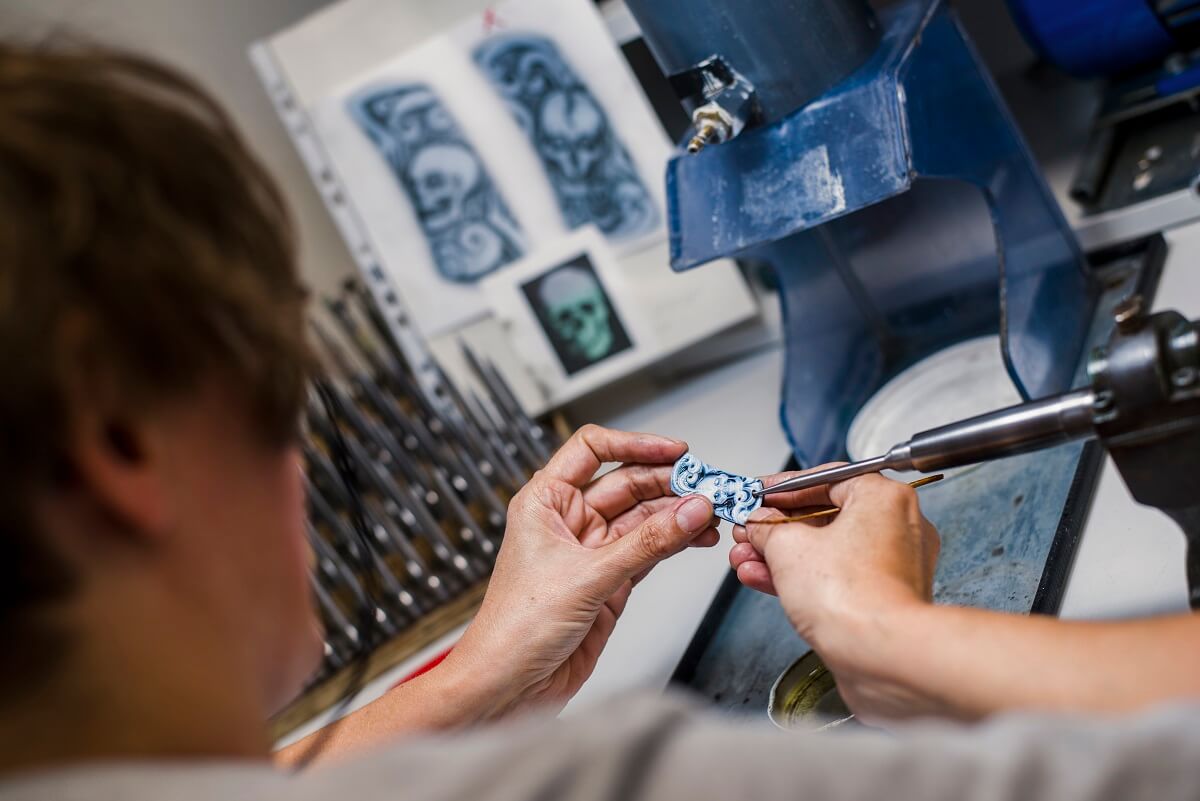
Anja Schuessler engraving at the spindle, drawings and tools in the background
As an engraving artist you are likely to work with highly valuable gems. Are you aware of the responsibility while processing? Or, can you just switch the fear off?
Anja Schuessler:
As an engraver of cameos, I mainly work with agates which are not really valuable. But of course, I have felt that fear of breaking them, even with less valuable gems. By now, I can just switch it off completely, being aware that I am dealing with just a stone which is replaceable. Furthermore, a stone is not ruined when making a mistake while cutting. An experienced engraver is able to change the pattern without anybody recognizing it afterward.
Susanne Mueller-Ostgen:
I always try to avoid these negative thoughts. The more I get hung up on the fear something could go wrong, the more likely it is that something bad will happen. It’s also important to always be focused and not get distracted. Stay cool! And everything will turn out alright.
Which materials do you prefer working with?
Susanne Mueller-Ostgen:
I like quartz best (citrin, amethyst, smoky quartz and rock crystal) besides my beloved agates as well as onyx and carnelian. They are rather easy to process and offer a great expression after the finish.
Anja Schuessler:
Banded agate, most definitely. Its hardness and its dichroism are perfect criterias for applying the relief technique. In addition, I prefer stones with a hardness of 7, just like agates. Anything harder or softer I cannot process with my tools.
Do you have a favorite piece?
Anja Schuessler:
My favorite piece is every piece I have completed successfully.
Susanne Mueller-Ostgen:
In my case, it’s my masterpiece. Up until today, I haven’t got a clue how I managed to successfully complete such a large engraving of such high quality within only 40 hours.
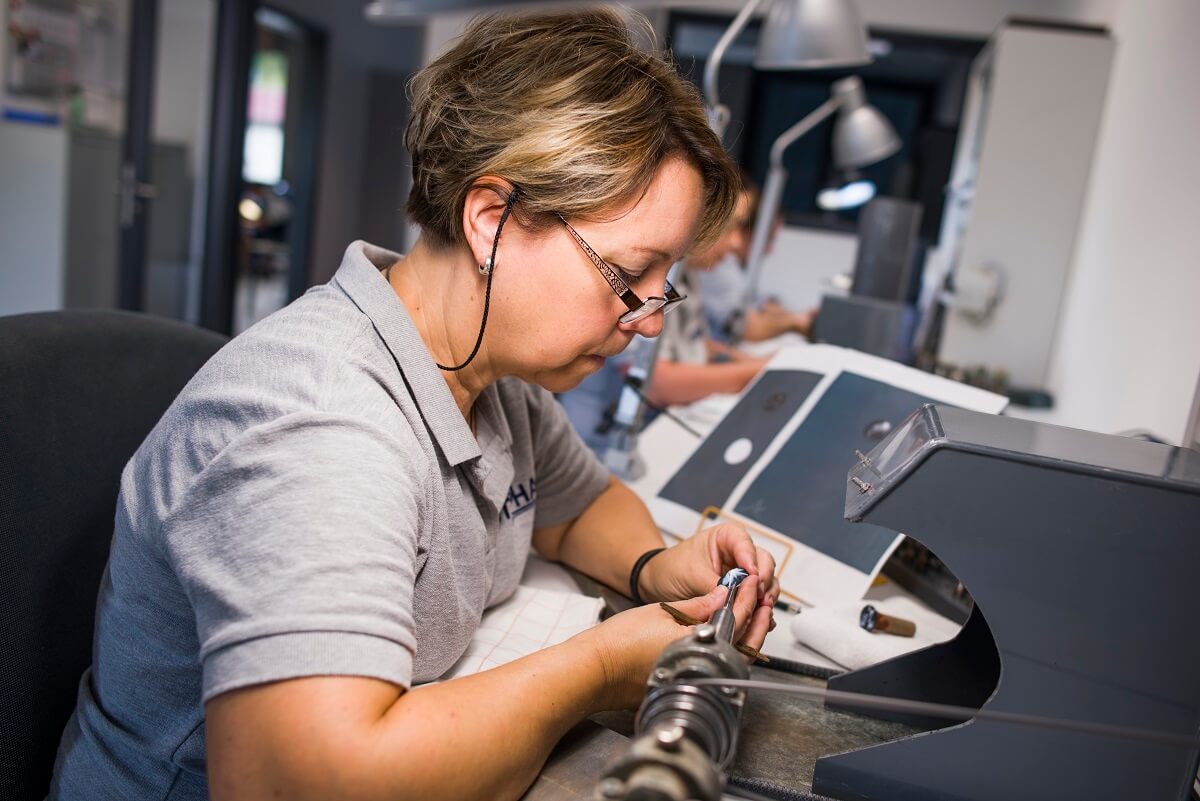
Susanne Mueller-Ostgen at the engraving spindle
In the past, which piece did you have to put the most work in?
Anja Schuessler:
All I can say is that in general, very small engravings are harder to do. Simply because the tools have to be accordingly smaller which is technically almost impossible to fabricate and this causes them to break permanently. This is really stressful and no fun.
Susanne Mueller-Ostgen:
For me, these are the works which require high precision fit and measurement accuracy. I am talking about technical and abstract stones which must fit into the settings created by the customers.
Which gem colors or which stone glitters best for you?
Susanne Mueller-Ostgen:
I think boulder opals are beautiful. They shimmer in all colors of the rainbow. Definitely one of my favorite gems.
Anja Schuessler:
For me, it’s the aquamarine.

